Close Wisconsin Avenue Through the Marquette Campus?
In 1992, Marquette proposed closing Wisconsin Avenue to vehicular traffic between North 11th and North 16th streets, as well as one-block sections of North 12th and North 13th streets between Wisconsin Avenue and Wells Street. The project was called Avenue Commons and the intent was to create a pedestrian mall in the reclaimed roadway. At the time, Wisconsin Avenue was three-lanes in each direction and Marquette was a school in flux with financial challenges and a perception of having an unsafe campus. Closing a section of Wisconsin Avenue was intended to make the campus safer and more attractive, and the closing would have had a big impact on the university and city, but would it have been positive?
Today, Wisconsin Avenue includes two lanes in each direction as it crosses the Marquette University campus. In addition, it includes wide sidewalks, a sizable, attractively landscaped median complete with Marquette branding, and curb space for bus stops and parking. At the time of the proposal, Wisconsin Avenue had three lanes of traffic in each direction, which enabled traffic to speed through the Marquette campus. It also lacked the wider sidewalks, and only had a small median complete with run-of-the-mill street lights. It was far from a grand avenue, and did little to make the campus seem worthy of one’s attention. Wells and State streets were also a one-way street at the time (they were converted to two-way traffic from 11th to 27th streets in 2004), further painting the campus as a mere pass-through on the way in-and-out of downtown.
In April of 1994 at the direction of the Common Council, the City Engineer coordinated a study (see: Footnote 1) of the impacts of the proposed closures, primarily on the existing transportation system. The report contains three alternatives for handling the displaced traffic, No Build, Alternate Route, and Tunnel. Ultimately, the Common Council adopted none of these plans, but for the sake of debate let’s examine them.
Background
The study includes a large amount of data, the most important of which I have attempted to include in the scanned images shown below in the photo gallery. Of note, the closure of Wisconsin Avenue would have not only directly impact more than 22,000 vehicles per day that used the very stretch at that time, but 1,081 bus trips, totaling 17% of MCTS’s total buses in operation at the time, and approximately 22,000 daily riders.
Given the odd path the proposal took through the Common Council, and how divided the community was on the issue, there are a substantial number of articles available in the Google News archives about the topic.
Of interest, at one point covering Interstate 43 with a plaza was discussed as part of the plan. Something we’ve discussed in the past.
No Build
This option clearly would have been the cheapest when considering the capital costs of implementing it, but it likely would have produced highly undesirable results. The additional roadways would have seen a significant increase in traffic, which would have made them nearly as bad to cross as Wisconsin Avenue was at the time (and arguably defeated the purpose of the closure). In addition, the closures would have made it more difficult to access the campus, especially given that there was no plan to convert Wells Street to two-way traffic with this alternative. Confusion to general motorists as to why a street abruptly terminated would have been a persistent cause of backups.
Tunnel
I can’t imagine a tunnel was ever a serious consideration, and digging through the archives of the Journal and Sentinel seem to confirm this. Never the less, the plan called for $30,070,000 to be expended for the construction of the tunnel as well as sewer and water infrastructure relocation. Not budgeted was relocation of utilities from the Wisconsin Gas Company, Wisconsin Electric Power Company, and Ameritech. Who would have been liable for the utility relocation if the tunnel was built? Your guess is as good as mine, but it bears a bit of similarity to the current debate over the utilities and the Milwaukee Streetcar, as well as a major road project that occurred next door and required millions in utility relocation expenses, the Marquette Interchange. While providing a vehicle-free street to those above, the tunnel was expected to cost the City $46,400 annually in lost revenue and operating/maintenance costs, as well as having caused MCTS to lose 93,275 rides a year for an annual impact of $176,550.
Why this option was studied is unclear, because I can’t imagine a single scenario where Marquette, the City of Milwaukee, or the State of Wisconsin would have paid for this. Ironically, there were formerly tunnels under Wisconsin Avenue, but they were for pedestrians. They were in place from the 1930’s to the early 1970’s and were ultimately closed because of safety concerns.
While this option may have had the smallest impact on the city as a whole by still allowing traffic to flow in a near grid-like fashion through the area, I think it ultimately may have impeded access to the center of Marquette’s campus by forcing those coming by car, bus, or, at the time proposed, light rail to enter from the outside, instead of allowing street grid access to the heart of the campus today. All that in addition to the fact that the money just wasn’t there for this option.
Alternate Route
Multiple alternate routing options were studied, including a busway along Wells Street and a Short Diagonal Connector. Given that the Long Diagonal Connector with a two-way Wells Street was the recommendation of the study I will stick with discussing that. The Long Diagonal Connector was recommended because it had the smallest impact on traffic of all of the options proposed, while actually staying financially feasible, unlike the tunnel.
The Long Diagonal Connector would have pleased motorists greatly over the no-build option. It would have included the acquisition of property for a new roadway that connected West Wisconsin Avenue with Clybourn Street between 16th and 18th streets, allowing smooth access around the campus. It seems likely there would have be a great amount of political pressure applied to ensure this proposed road would be as free-flowing as possible, which in the long-run would have made Marquette seem like an island in the city by discouraging development facing it.
An additional part of the recommendation was to convert Wells Street into a two-way street from 10th or 11th to 16th or 17th streets, something that ultimately would not happen until State and Wells were both converted in 2004.
The diagonal street would have required the acquisition and demolition of buildings and parking lots, removing them from the tax-base, and no doubt influencing how and where Marquette has developed many of its recent campus additions.
The cost to build the Long Diagonal Connector and Two-Way Wells Street was estimated to be $9,840,000, with annual costs to the city of $82,900. The annual impact to MCTS was estimated to be $777,200, with a loss of 209,150 rides.
Conclusion
It’s easy to understand how the closure of Wisconsin Avenue might have seemed logical on the surface in the early 1990’s (see: Footnote 2). Wisconsin Avenue was a six-lane road, the university was struggling, the stigma of Dahmer hung over the campus (and city), Wells and State were one-way highways, and many of the new buildings along Wisconsin Avenue weren’t even on the drawing boards (Zilber Hall, Engineering Hall, the Blood Center, etc., etc.). Wisconsin Avenue was essentially a surface highway through the Marquette campus.
The proposal was sent back and forth from the full Common Council to committee multiple times, ultimately failing. At one point then-Mayor John Norquist offered his input publicly on the issue, but although his suggestions mirror how the configuration is today, even his suggestions were ignored for years.
The Avenue Commons proposal came down to one alderman in the end, with southside Alderman Robert A. Anderson changing his likely vote from a yes (which he voted in committee) to a no. He did so apparently at the suggestion of his wife, which angered some in the community. I’m pretty certain Anderson didn’t envision Wisconsin Avenue and Marquette interacting as they do today, but his change of heart has led to Marquette becoming a school that is well integrated into the city, and a far greater asset than it was before the proposal.
Street closures are generally a bad idea, the street grid exists to provide predictable, easy transportation for all vehicle types. Cutting off one piece not only makes that area harder to access, but increases stress on other areas of the grid. Couple that overarching philosophy with the street grids challenges near Marquette, including the vast amount of one-way streets, a number of abruptly terminating streets because of the hospital and campus, and the overwhelming barrier Interstates 43 and 94 create (and the lack of bridges that cross them), and it’s clear that closing that small stretch of Wisconsin Avenue would have seriously impeded the flow of thousands of bus riders and drivers.
It took time, until the Marquette University Campus Identity and Beautification was executed in the early 2000’s, but Marquette eventually got it right. Wisconsin Avenue is now the front-door to the campus, and an asset to the city. The street has been tweaked ever so slightly to remove a driving lane and calm traffic, streetscaping in the median has made clearly defined areas for pedestrian crossing making it safer for pedestrians and drivers, and signage has been installed to proclaim to all who cross that you are entering the Marquette campus, or rather “We Are. Marquette.”
- MCTS Bus Routes Through Area
- Long Diagonal Connector – Recommend Alternative
- Proposed Busway on Wells Street
- Traffic Count Data in 1994
- MCTS Ridership on routes impacted by Avenue Commons
- Map of proposed Avenue Commons street closures
- The proposed Wisconsin Avenue tunnel with the closed Wisconsin Avenue above.
- Financial Impacts of Various Alternatives
- Wisconsin Avenue Today from Google Maps
- West Wisconsin Avenue in the 1974
Footnote 1 – For those interested, this report can be found at the Milwaukee Public Library. It is titled “Proposed West Wisconsin Avenue Closure – Feasibility, Cost, and Neighborhood Impact Report”. Some of the more wonk-ish reading you will ever do, but you might find it enjoyable. The scans presented in this article are from it.
Footnote 2 – The Milwaukee Sentinel (prior to the merger with the Journal) Editorial Board wrote a number of editorials endorsing the plan. They include (but aren’t limited to) editorials on April 18th, 1994, June 23rd, 1994, August 17th, 1994


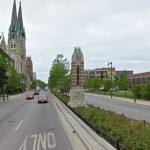
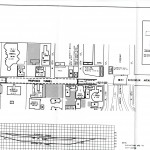
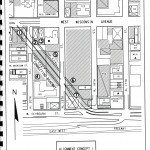
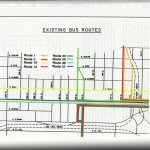
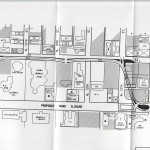

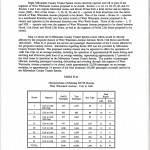
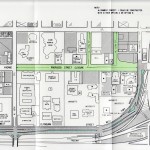

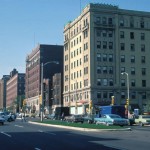



















Thanks for this article – it’s always good to learn about the plans of the past. I have a couple of reactions:
1. While West Wisconsin looks much better than it did, it appears to have been built with a very wide outside lane. It looks to be around 18′ wide making the roadway about 30′ in each direction. I’d be surprised if that did not lead to speeding and unsafe crossings. Presumably this was done for the convenience of through traffic and drop-offs, but there are plenty of other places to drop people off around there and increased speeds for through traffic should not be the goal for urban streets. Hopefully this can be rebuilt with 10-11′ lanes and the difference used for boulevards or cycle tracks.
2. Sorry if I missed it, but I’m a bit unclear on what was proposed to replace West Wisconsin. Were they vacating ROW and replacing the street with green space? If only motor vehicles were to be prohibited, then it would likely still provide an important function and serve a significant amount of pedestrian and bicycle traffic. Frankly I’m baffled that they were proposing to remove buses from the street – it seems like it would have worked really well as a transit mall.
@Alex
1. That would be an improvement.
2. It wasn’t completely clear, but at various points a park was mentioned. I believe this included installing grass around the church and 12th Street. People suggested allowing buses on the street, but I don’t think that would have worked with what Marquette was envisioning.
I have to admit I had no idea this was ever proposed. Really interesting read about what the city was considering. Was it ever a consideration to pedestrianize the street but allow busses and bikes access. Would of avoided the MCTS revenue loss…
@Spencer
I’m sure that was considered, and I can find various mentions of it (although none from Marquette), but it seems Marquette was intent eliminating the street aspect in various points.
In addition, the study noted that the busway option might pose a safety concern as pedestrians might not be looking for buses, and that buses would be traveling at an increased through that stretch.
A great post Jeremy, and a very interesting walk down memory lane. I was very involved in the community redevelopment efforts around Marquette at the time of this effort, so I know of many other perspectives on the subject.
Of course, most of us who follow Urban Milwaukee tend to have a bias toward keeping streets open and clearly this bias has shaped your interpretation of events. I don’t necessarily disagree with you, but the conclusions are somewhat self-fulfilling. The study you base much perspective on is the City’s study done by the City Engineer. It might have been at least interesting to know that MU had its own master plan study done by a national urban planning firm – Sassaki Urban Planning group I think – that gave very detailed rationale for doing the Avenue closing. Of course, consultants often identify conclusions desired by their clients, but in this case, there was a reasonable level of objectivity in studying the matter. Of course, that said, the goals the University desired to achieve would not necessarily by completely congruent with the goals say the City of Milwaukee would have aimed to achieve were they the client. Nonetheless, the study commissioned by MU had some powerful data.
Many people close to the issue understood that the “no build” and the “tunnel” options were pretty much all the City’s idea just to have a couple mostly useless ideas that could be thrown out. The “by pass” route was the only MU proposal sought. The City study misses the two additional benefits of the plan. First, there was a planned Esplanade, which was a huge urban park to be located in front of Gesu Church and combined with new housing to be created around the edge of it. Second, there was a proposed bridge over I-43 to connect the new campus mall to downtown. There is an example of this type of freeway bridge in Phoenix that has a well-known Japanese Garden and a major park on top of Interstate 10. MU had studied this option and had garnered support from the congressional delegation at the time which was working on federal funding possibilities for this.
Another key finding of the MU study was that traffic on Wisconsin Avenue consistently sought strategies to get off of Wisconsin Avenue due to the difficulty of getting to and through downtown while navigating all of the challenges of the Avenue. I can relate to this as I agree it is a very frsutrating street to drive through. While I understand that no urban advocate wants to facilitate moving traffic “around” a major street, the fact of the study shows that that’s what people did (and do) and instead they race through side and neighborhood streets causing other issues. The MU bypass route got everyone over to Michigan effortlessly. There were some reports of bus system projections of lost ridership, but it never made much sense.
The loss of tax base by land taken was minimal. Much of it was MU anyway. The new construction on the Esplanade might have mitigated much of it. Its also somewhat simplistic to reference the new buildings on Wisconsin Avenue “weren’t even on the drawing boards yet”. In reality, major players were seriously threatening to leave downtown, for example the Blood Center had specific plans to go to the County Grounds / Regional Medical Center. The Wisconsin Avenue plans and the related Campus Circle efforts at the time persuaded them to reconsider.
And lastly on politics – let’s just say that the people involved at the time could tell plenty of stories if they were willing to talk. While the story about Anderson is known and perceived to be what stopped the effort, there was another Alderperson that pledged support and switched creating a blind-side that really killed it.
In the end, I think there is a strong case to be made that modifying Wisconsin Avenue in the way originally proposed would have been suboptimal for Milwaukee. You make that case well. But, I think coming at this just with that bias avoids the tougher analysis. Could MU possibly have become a much grander campus than now had this whole project happened as planned? And, perhaps more to your point, could Milwaukee have been grander and better too? I honestly don’t know. I do think I intuitively prefer the Avenue open and certainly think the current street is better than the old. But I do wonder, knowing all that I know.
In any case, thanks for the exploration. Its fascinating stuff. And was that really almost 20 years ago?! Wow.
@Juli – Thanks for filling in more details. What I failed to mention is the article was inspired by me finding the study randomly in the Central Library while looking for something else. I didn’t find that Marquette had a collection of information on the issue up until the day I actually finished off the article, and still didn’t realize they had their own official study.
I must admit I am no expert on Marquette’s campus, especially how it historically was, so much of the speculation on how it could have been with a closed street is difficult for me to imagine having no real point to jump off of.
The freeway covering makes the whole project much more appealing, but I couldn’t find much published data on it unfortunately.
Thanks for the feedback.
Juli’s comments above are accurate.
I headed the MU revitalization effort and only want to add one perspective.
MU inherited a problem not of its making back in those days. Crime, drug houses, abseentee landlords and of course the whole Dahmer thing affected the University. Every newspaper story about Dahmer showed a map of his apartment and a nearby MU dorm. MU enrollment efforts faced a crisis.
At lightning speed MU enlisted a team of consultants from real estate, urban revitalization, legal and university resources. The Board of Trustees gave the go ahead to begin revitalization efforts and seek partners from the neighborhood and elsewhere to help. The reaction was overwhelming. We bought up drug houses, got the Milwaukee police to open a sub station in the neighborhood to begin community policing, acquired hundreds of sub standard housing units, rehabed hundreds of properties, built new housing and commercial development. We engaged the neighborhood and got a lot of support. The project got national attention for MU and the City and many other universities facing similiar challenges came to learn from us.
This was done largely with private funds. The City was a good partner along the way helping with approvals and other
needed designations.
What MU sought in the Avenue rerouting project was to put in the crown jewel of its master plan. In my opinion the City got a major 100 block neighborhood renewal accomplished without the use of City funds. It was like a gift to the City. A gift worth hundred’s of millions of dollars. In return it sought the City’s help in completing the effort through the Avenue rerouting. I believe its too bad that the effort failed regardless of who’s fault it was. Those of us who say the dream of the campus without the Wisconsin Avenue bifurcation knew what it would have done for MU and the City. I believe MU’s efforts were not fully understood and deserved more support.
I can’t comprehend how closing WI Ave would be better than how it is today. I guess vague comments that what they were planning was good doesn’t reasonate with me. After seeing so many half-completed projects in this city, I don’t have the confidence that somehow simultaneously cutting a busway/diagonal scar through the neighborhood, all the while creating an island in the city… would have somehow be better for the City of Milwaukee, let alone Marquette.
If this plan had succeeded, I see it would have reinforced an us vs them mentality… they’ve built the moat and got an island to put academic buildings on. As someone who was not involved and just remembers the news coverage from years ago, I’m glad this never happened.
Similar to this, I wonder how history would have been different if Condordia University had not moved their college & had reinvested in their campus as Marquette has done. Obviously, this would have required the City of Milwaukee to be an active participant… but I look at that as a serious missed opportunity. However, in the end it’s all a game of what-if and we’ve got to work with what we’ve got.